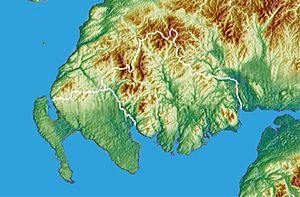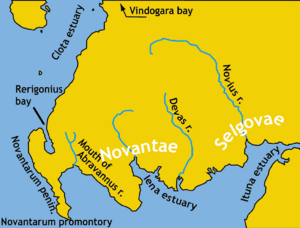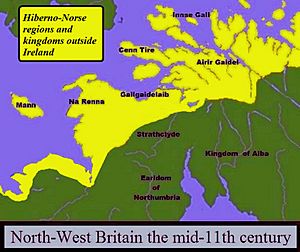Galloway facts for kids
Quick facts for kids
Galloway
|
|
|---|---|
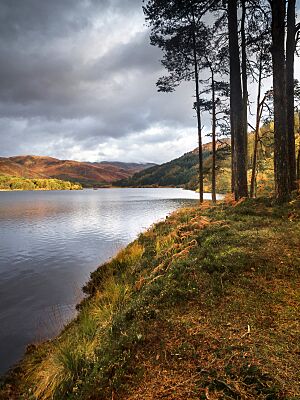
|
|
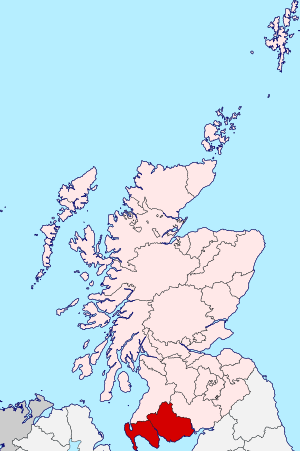
Galloway (red) shown in Scotland (pink) shown in the United Kingdom (light grey)
|
|
| Demonym(s) | Gallovidian |
Galloway is a beautiful region in southwestern Scotland. It includes the historic areas of Wigtownshire and Kirkcudbrightshire. Today, it is part of the council area called Dumfries and Galloway.
People from Galloway are known as Gallovidians. The name "Galloway" comes from the Gall-Gàidheil. This means "stranger Gaels." They were a mix of Gaelic and Norse people who settled here around the 900s.
Galloway is surrounded by the sea to the west and south. The Galloway Hills are to the north. The River Nith forms its eastern border. The River Cree separates Kirkcudbrightshire and Wigtownshire. The size of Galloway has changed a lot over history.
A strong, black, hornless type of cattle called Galloway cattle comes from this region. There is also the unique Belted Galloway, often called a "Beltie," which has a white band around its middle.
Contents
Exploring Galloway's Landscape
Galloway is the part of Scotland south of the main watershed in the Southern Uplands. It is also west of the River Nith. People often say it stretches from "the braes of Glenapp to the Nith."
Three main rivers flow north to south: the Urr Water, the Water of Ken and River Dee, and the Cree. Their valleys offer good arable land for farming. Some good farmland is also found along the coast.
However, much of the land is rugged. The soil is often shallow. Galloway has a mild and wet climate because it slopes south towards the coast. This makes it great for growing grass and raising animals.
The northern part of Galloway is very wild and rugged. It forms the largest natural wilderness area in Britain south of the Highlands. This wild area is known as the Galloway Hills.
What People Do in Galloway
Galloway has always been known for its horses and cattle. Even today, producing milk and beef are very important industries. There is also a lot of timber production from forests. Some people work in fishing.
The many hills and high rainfall make Galloway perfect for hydroelectric power. This means using water to make electricity. The Galloway Hydro Electric Scheme started in 1929. Since then, making electricity has been a big industry.
More recently, wind turbines have been built on the hills. A large offshore wind farm is also planned. These projects help Galloway produce even more 'green energy' from natural sources.
Galloway's Rich History
Ancient Landmarks on Ptolemy's Map
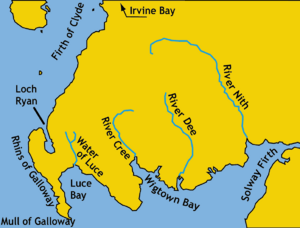
A geographer named Ptolemy made a map of Britain in the 100s AD. This map was part of his book, Geography. He described important places and the people living there. Many of these places are in Galloway.
One important place in the west was called Rerigonium. This name means 'very royal place'. It is thought to be the same as Pen Rhionydd. This place is mentioned in old Welsh stories as one of the 'three thrones of Britain'. It is linked to the legendary King Arthur. Rerigonium might also have been the main town of the ancient kingdom of Rheged.
We are not sure exactly where Rerigonium was. But it was 'on Loch Ryan', near modern Stranraer. Some think it might be the modern town of Dunragit, which means 'Dun Rheged'.
Early People and Monuments

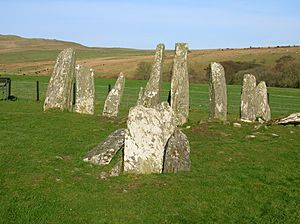
The first people we know about in Galloway were the Brythonic Celts. The Romans called them the Novantae tribe.
Long ago, before the Romans left Britain, St. Ninian is said to have built a church or monastery. This was in Whithorn, Wigtownshire. It became a very important place for pilgrimage (religious journeys). People visited it until the Reformation changed religious practices in Scotland.
Galloway has many ancient monuments. Some of the most famous are the Drumtroddan standing stones. These stones have special cup-and-ring carvings. There is also the Torhousekie Stone Circle. Both are in Wigtownshire. Cairnholy is another important site. It is a Neolithic chambered cairn, which is an ancient burial mound. Scientists also found one of Europe's earliest pit-fall traps near Glenluce, Wigtownshire.
Galloway in the Middle Ages
A kingdom where people spoke Brythonic languages ruled Galloway until the late 600s. Then, the English kingdom of Bernicia took control.
Later, between the 800s and 1000s, the English influence changed. Britons and Norse-Gaelic people became more powerful. This happened because the kingdom of Northumbria became weaker. Also, many Norse people settled around the Irish Sea. They came to places like the Isle of Man and western Cumbria, which is just south of Galloway.
Galloway might have become part of Scotland much sooner. But Fergus of Galloway became a strong leader. He made Galloway a powerful, independent area. Fergus, his sons, and grandsons, including Alan, Lord of Galloway, often changed their loyalty. Sometimes they supported the Scottish kings, and sometimes the English kings.
When they supported Scotland, a group from Galloway joined David, King of Scots. They invaded England and led the attack in the Battle of the Standard in 1138. But they were defeated.
Alan died in 1234. He had three daughters and a son who was born outside of marriage, named Thomas. The people of Galloway wanted Thomas to be their "king." But Alexander III of Scotland supported Alan's daughters and their husbands. He invaded Galloway. The people of Galloway were defeated. Galloway was then divided among Alan's daughters. This ended Galloway's time as an independent area.
Alan's oldest daughter, Derbhorgail, married John de Balliol. Their son, also named John, later became a candidate for the Scottish Crown. Because of this, many battles of Scotland's Wars of Independence were fought in Galloway.
After the Wars of Independence, Galloway became the land of Archibald the Grim, Earl of Douglas. In 1369, he received the part of Galloway east of the River Cree. He appointed a manager to run this area. It became known as the Stewartry of Kirkcudbright. The next year, he gained the part of Galloway west of the Cree. This area continued to be managed by the king's sheriff. So, it became known as the Shire of Wigtown. From then on, the two parts of Galloway were managed separately. They became separate counties.
Whithorn remained an important place for culture. All the medieval kings of Scots made religious journeys there.
Galloway in More Recent Times
The Galwegian Gaelic language was spoken in Galloway for a long time. It lasted longer than Gaelic in other parts of Lowland Scotland. The last known speaker was Margaret McMurray (who died in 1760). She lived in Carrick, which is just outside modern Galloway.
After Scotland and England joined under one king in 1603 (the Union of the Crowns), Galloway saw big changes. This was during the War of the Three Kingdoms and the Covenanter rebellion.
In modern times, Stranraer was a very busy ferry port. But the ferry company has now moved its services to Cairnryan.
Galloway in Books
Galloway has been the setting for many novels. One famous example is Walter Scott's Guy Mannering.
Other books include a historical fiction series by Liz Curtis Higgs. These are Thorn in My Heart, Fair is the Rose, and Whence Came a Prince. In John Buchan's novel The Thirty-nine Steps, the character Richard Hannay hides in Galloway.
Five Red Herrings is a mystery novel by Dorothy L. Sayers. It was also called Suspicious Characters in the US. In this book, Lord Peter Wimsey is on holiday in Kirkcudbright. He investigates the death of an artist living at Gatehouse of Fleet. The book has wonderful descriptions of the countryside.
S R Crockett was a popular writer of historical romances before World War I. He set several of his novels in Galloway. These include The Raiders and Silver Sand.
Galloway is also featured in memoirs. One is Devorgilla Days by Wigtownshire author Kathleen Hart. It tells about life in Wigtown, which is known as Scotland's national book town.
See also
 In Spanish: Galloway para niños
In Spanish: Galloway para niños


